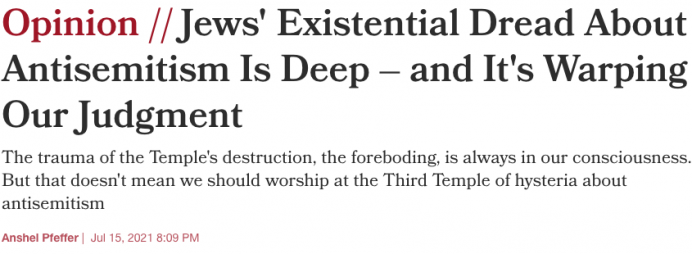Ben Cohen is the author of Some Of My Best Friends: A Journey Through Twenty-First Century Antisemitism. He responds here, robustly, to the recent claim of the Haaretz journalist Anshel Pfeffer that Jews are worshipping at ‘the Third Temple of Hysteria’ about antisemitism.
Anshel Pfeffer’s argument (‘Jews’ Existential Dread About Antisemitism is Deep – and Its Warping Our Judgement’, Haaretz, 15 July 2021) is a simple one.
Jews in Israel suffer from an eternal, irrational sense of dread regarding the existential threat to their homeland posed by their neighbours. Trapped by a similar mindset, Jews in the diaspora fret endlessly about the antisemitic resentments nursed by those around them, processing a handful of admittedly ugly incidents carried out by a small minority of non-Jews through the filter of European barbarism in the previous century. Such irksomely sensitive emotions are not warranted in this day and age, Pfeffer counsels, and it would be best to get over them and move on.
Along the way, he quotes an individual he describes as a ‘fairly well-known…centrist…diaspora Jewish leader’ telling a meeting at which Pfeffer was present that antisemitism had reached its ‘highest point’ since the end of World War Two. (Pfeffer’s representation of this conversation is mischievous. After telling his readers that the meeting took place under the Chatham House rule, which frowns upon any subsequent reports that reveal the ‘identity’ or ‘affiliation’ of a speaker, Pfeffer then divulged enough information about this Jewish leader for anyone with inside knowledge to have a pretty good idea of who, out of five or six possible candidates, was being quoted. Moreover, since the Chatham House rule prevents this same diaspora Jewish leader from responding to Pfeffer’s article, we are forced to rely on Pfeffer alone for the accurate summation of an argument that he invoked solely to belittle it!)
Pfeffer’s scorn for this Diaspora Jewish leader rests on what might kindly be called his arbitrary periodisation of postwar antisemitism. He draws a ‘before’ and ‘after’ line through… the current year, 2021. ‘[H]ow he could say that,’ he complains of the Diaspora Jewish leader he quotes, ‘a man who in his lifetime, and in the Western country where he was born, there were schools, colleges and clubs where Jews were either barred from membership or limited by a quota? How he could say that when, since 1945, we’ve seen Jews massacred at Buenos Aires’ AMIA, Toulouse’s Etz Ha’Torah [sic – the correct name of the school where a teacher and three young children were executed was Ozar Hatorah] and Pittsburgh’s Tree of Life?’
Later on, Pfeffer comments that ‘since the end of WWII, millions of Jews living in the Soviet bloc had to hide their Jewish identities, were imprisoned for studying Hebrew and celebrating chagim, were kept out of senior positions, and prevented from emigrating. In more recent years we’ve had waves of Islamist terror targeting Jews in Europe and then antisemitic white supremacist terror in America.’
Because all these events occurred before the latest outbreak of fighting between Israel and Hamas in May 2021, Pfeffer appears to be saying, they belong to the past, to a time that is thankfully just a memory; ergo, anyone who says that antisemitism right here, right now is at its highest point since 1945 can only be exhibiting signs of ‘hysteria,’ a word that Pfeffer is overly fond of.
If we were going to be pedantic, we could make the case that antisemitism has reached historic crisis levels even by comparison with Pfeffer’s impromptu list of anti-Jewish outrages from 1945 to 2018-ish. During the COVID-19 lockdown of the past 18 months, antisemitism soared on both sides of the Atlantic, most notably through the transmission of social media messages blaming the virus on a Jewish conspiracy, although physical assaults, vandalism and verbal abuse were still daily occurrences faced by Jews in multiple countries. Of course, in 2019, the year prior to the lockdown, antisemitic incidents increased in Germany by 13 per cent, in the United Kingdom by 7 per cent, and in France by an eye-watering 74 per cent; only through the imposition of a lockdown in 2020 was it possible to reduce the number of violent assaults on Jews, hardly the most comforting observation, and certainly no basis for arguing that antisemitism is less severe now than in some undefined past.
It wasn’t just coronavirus either. Across Europe, governments and judiciaries failed to protect their emancipated Jewish citizens from antisemitism, and in some cases even colluded with it. In France, the antisemitic murderer of Sarah Halimi, an elderly Jewish woman viciously beaten to death in her Paris apartment in April 2017, was excused by the country’s highest court from a criminal trial on the specious grounds, widely panned by psychiatric experts inside and outside France, that his intake of cannabis on the night of the killing had rendered him temporarily insane and thus criminally not responsible. Only the most tone-deaf analyst would dismiss the agonised fury among French Jews in the wake of this decision as ‘hysteria’ over antisemitism.
In countries across eastern Europe, the trend of Holocaust distortion and relativisation – equating the suffering of the majority Christian populations under Nazi occupation with that of the Jews, prosecuting historians and researchers who examine the phenomenon of local collaboration in the deportation and extermination of Jewish communities – continued unabated. In Poland specifically, the Sejm went so far as to pass a bill this year effectively closing off the restitution claims of Holocaust survivors and their descendants. When Israeli leaders and Jewish organisations objected that the legislation was an act of antisemitism, ‘greedy Jew’ memes cropped up throughout the country’s right-wing nationalist media in response.
Then there is the US. After the massacre at Pittsburgh’s Tree of Life Synagogue – which took place in October 2018, not 1918 as one might imagine to be the case from Pfeffer’s talk of contemporary ‘hysteria’ – violent antisemitism did not abate. Three Jews and a police officer died in an antisemitic shooting attack on a kosher market in Jersey City in Dec. 2019. Numerous violent assaults were reported at Chabad centres and other Jewish institutions around the country, among them a gun attack on a Chabad religious service in Poway, California, in May 2019 that left one woman dead. In Brooklyn, for at least 12 months before the pandemic hit, unsuspecting Orthodox Jews walking alone in several neighbourhoods of the New York City borough were the victims of a new trend: sucker-punches, and sometimes worse, delivered to the head and face, mainly by young Black males who then quickly fled the scene. And in May 2021, of course, we witnessed the spectacle of Jews being attacked by pro-Palestinian demonstrators – the majority of them Arab-American males in their teens and twenties – on both coasts.
I could go on, perhaps by pointing out that in South Africa over the last year, there has been no let-up in the antisemitic invective emanating from parts of the African National Congress (ANC) leadership. In May, ANC deputy secretary-general Jessie Duarte called for a national boycott of Jacobs Coffee (a popular local brand that sounds like a Jewish business, but which on closer inspection turns out to be the innovation of a German entrepreneur who emigrated to South Africa at the end of the nineteenth century) in order to prevent Israel from embarking on the ‘colonization of the African continent.’ Or I could mention Chile, where the present frontrunner in this November’s presidential election, Daniel Jadue, a Communist Party candidate of Palestinian descent, has terrified the country’s Jewish population of 20,000 by telling them that he doesn’t have a problem with Jews, just ‘Zionists.’ As Pfeffer is no doubt aware, since he discusses the USSR in his article, this same false distinction underpinned the Soviet Union’s Jewish policy, expressed domestically through the measures that Pfeffer mentions, and internationally through a campaign of anti-Zionist propaganda demonising Israel as a ‘racist’ and ‘apartheid’ state – exactly the same themes pushed by the campaign to boycott Israel that now engenders unreasonable ‘hysteria’ among diaspora Jews.
But enough nit-picking. The overriding point is that it is futile to try and quantify whether antisemitism was ‘worse’ in 1953, or 1968, or 1975, or 2009, or 2020. ‘I can calculate the motions of the planets,’ Sir Isaac Newton was supposed to have said, ‘but I cannot calculate the madness of men’.
Instead, a far more helpful approach is to regard the period since the Holocaust as a continuum in which three key factors have played the determining role. Firstly, as Pfeffer is keen to acknowledge, the vast majority of Jews enjoy historically unparalleled levels of political and civil rights. In part, this is the consequence of the grinding, ultimately successful political struggles waged by earlier generations of Jews and their allies in democratic countries, especially after the Dreyfus Affair in France in 1894. But it is also because Jews were ethnically-cleansed long ago from those states where they were exposed to systemic oppression, in the Arab world as well as in Europe.
The continued existence of Israel as a sovereign state is the second pillar of this postwar empowerment, and the majority of Jews today still appreciate the extraordinary historical significance of having a Jewish state among the world’s democracies. The declared aim of the anti-Zionist boycott campaign and the broader Palestine solidarity movement is the dissolution of Israel as an independent Jewish state, a goal that is more concerned with restoring Jews to the perilous 1948 status quo ante than with achieving Palestinian statehood within a realistic and peaceful framework. When tens of thousands in cities around the world march in support of this goal – as they did in May, when antisemitic outrages shot up, more than doubling in the US alone – it is local Jewish communities that pay the price. That is precisely why the equation of antisemitism with anti-Zionism is not some convoluted abstraction, as some of the Jewish state’s adversaries maintain, but a concrete representation of the reality these communities consistently face.
The third factor is the persistence of antisemitic beliefs and attitudes across nearly all societies, irrespective of whether the country in question is home to a sizable Jewish population, a small one, or none at all. The question of why this is the case needs to be confronted and analysed, rather than waved away, as Pfeffer does with his trite conclusion that ‘a lot has changed’ in the 2,000-odd years since the Second Temple in Jerusalem was destroyed by the Roman invaders, and therefore his fellow Jews should stop ‘worshipping at the Third Temple of’ – of course! – ‘hysteria.’
Completely absurd is Pfeffer’s dismissal of antisemitic anti-Zionism as just a bit of ‘criticism of Israel on social media’. His failure to grasp a phenomenon described 40 years ago as ‘antisemitism dressed up as anti-Zionism’ by the historian Eric Hobsbawm, no friend of Zionism, is an astonishing and a depressing illustration of how some Jews on the left are so desperate to dilute the seriousness of contemporary antisemitism that they will reach for the most superficial, impressionistic arguments.
Ironically, many of the antisemitic events listed by Pfeffer resonate today because their victims are still denied justice. He mentions the 1994 bombing of the AMIA Jewish centre in Buenos Aires, in which 85 people died and more than 300 were wounded: 27 years later, the Iranian regime which orchestrated the atrocity with its surrogate, Hezbollah, remains in power; none of the six Iranian and Lebanese subjects of Interpol red notices for the bombing have been apprehended, much less stood trial; and Cristina Fernandez de Kirchner, the former Argentine President who pushed through a secret agreement with Iran in 2013 that abandoned any legal redress for the AMIA victims, is now back in government. For as long as these facts remain in place, the moral scandal that is the AMIA bombing and its aftermath can never be a purely historical episode, no matter no much time elapses.
There’s a final point that’s worth bearing in mind. While the basic ideas informing the antisemitic worldview have largely remained the same over the last two hundred-odd years, its adherents have proven themselves to be remarkably adept when it comes to inserting themselves into issues and causes that, on the surface, have little to do with Jews, but which are rooted in the same conspiratorial ruminations that animate antisemitic thinking. The Covid-19 skeptic movement has provided one platform for this entryism, as did the anti-war movement that coalesced more than a decade earlier, while the growing enthusiasm for cryptocurrencies, commonly depicted as financial instruments freed from the strictures of powerful globalised banks, is just one of a range of potential opportunities for the foot-soldiers of antisemitism to step in and change the subject.
That is why speculation about antisemitic trends, attempts to understand where Jews stand now compared with a century ago, and vocalised concern over antisemitism rising once again as knowledge of the Nazi period is simultaneously fading, should not be tossed aside as ‘hysteria’ – a series of hyperventilating, melodramatic reactions to phantom worries. For as the family of Sarah Halimi will confirm, these are manifestly not phantoms.






































Same, but different academic hypocrisie: in June 2019, the German philosopher Peter Sloterdijk fantasizes about Jewish “Alarmismus” (modern term for “hysteria”). – Nazis shot down Walter Lübcke in Kassel in the same month, and in October 2019, another Volksgenosse murdered in Halle, fourtunately failing the target to kill the people assembled in the synagogue. The famous philospher, of cause, never has commented his cynical “error” until today. Many other German scientists like Wolfgang Benz, specialist for the studies of antisemitism, meanwhile nevertheless didn’t hesitate to support the Jerusalem Declaration, totally ignoring, what every day shows.
https://www.juedische-allgemeine.de/kultur/professor-sloterdijk-gibt-entwarnung/